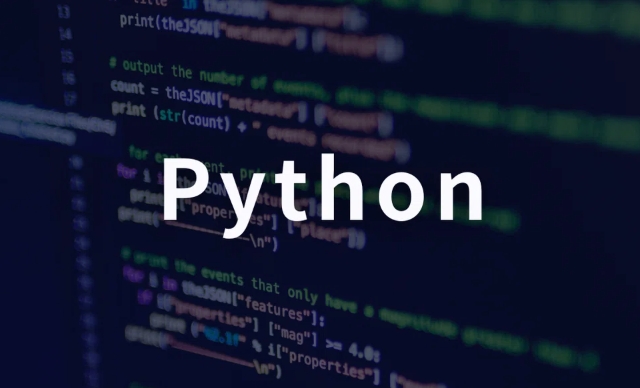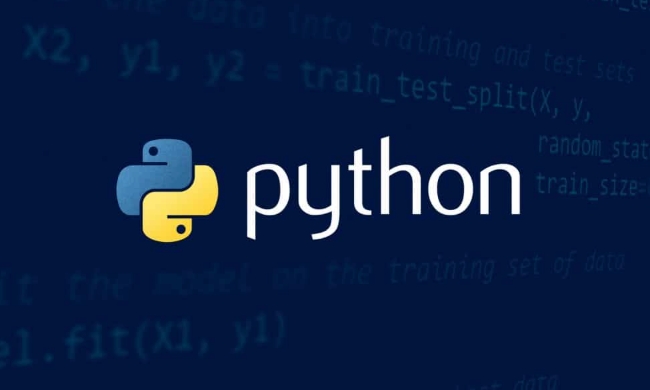SVM is a classification algorithm suitable for high-dimensional data. It realizes classification by finding the optimal hyperplane, especially suitable for medium-sized data sets. Its core lies in maximizing intervals and dealing with nonlinear problems in combination with kernel functions. Common kernel functions include linear kernels, polynomial kernels, RBF and Sigmoid kernels. The process of using scikit-learn in Python is as follows: 1. Import relevant libraries; 2. Prepare and standardize data; 3. Split the training set and test set; 4. Train the model; 5. Evaluate the results. The key points of parameter adjustment include C parameter control regularization intensity, gamma control support vector influence range, kernel selection kernel function, it is recommended to try starting from the default value and combine grid search to optimize parameter combinations. At the same time, note that SVM is not suitable for large data sets and requires standardized features.

SVM is a classic supervised learning algorithm, especially suitable for classification tasks. In Python, the most commonly used implementation is SVC class provided by scikit-learn. It is easy to use and has good results, especially when the data dimensions are high but the sample size is not large.

Understand the basic principles of SVM
The core idea of SVM is to find an optimal hyperplane and separate different categories of data as much as possible. This "optimal" is reflected in the maximization of intervals. Simply put, it is not only necessary to separate the two types of points, but also to keep them as far away from the dividing line as possible.
The question you may encounter is: Why not use logistic regression or decision trees? That's because when the data is not particularly linear and separable, SVM combined with kernel trick can better deal with nonlinear boundary problems.

Common kernel functions include:
- Linear core
- Polynomial core (poly)
- Radial basis function (RBF, most commonly used)
- Sigmoid core
Which core to choose often depends on your data characteristics and actual effectiveness tests.

How to use SVM in Python
Python's scikit-learn library is very well encapsulated for SVM and is very convenient to use. Here is the basic process:
-
Import library
from sklearn.svm import SVC from sklearn.model_selection import train_test_split from sklearn.preprocessing import StandardScaler from sklearn.metrics import classification_report, accuracy_score
Prepare data The data is best standardized first, because SVM is more sensitive to feature scales.
scaler = StandardScaler() X_scaled = scaler.fit_transform(X)
Split training sets and test sets
X_train, X_test, y_train, y_test = train_test_split(X_scaled, y, test_size=0.2)
Training the model
model = SVC(kernel='rbf') # The default is RBF model.fit(X_train, y_train)
Evaluation results
y_pred = model.predict(X_test) print(classification_report(y_test, y_pred)) print("Accuracy:", accuracy_score(y_test, y_pred))
This is just a basic process, and the key is to adjust the parameters in detail.
SVM parameter adjustment techniques and precautions
The performance of SVM depends heavily on parameter settings. Here are some common parameters and their effects:
- C Parameters : Controls the regularization intensity of the classifier. The larger C, the more likely it is to punish misclassification, which may lead to overfitting; the smaller C, the higher tolerance, may be underfitting.
- gamma parameters : only for RBF, poly and sigmoid cores. The larger the support vector, the smaller the influence range, and it is easy to overfit.
- kernel : It is very important to choose the right kernel function. For example, image data may be more suitable for RBF, while text data is sometimes linear kernels are enough.
Suggestions for parameter adjustment:
- Start trying from the default value and adjust gradually
- Automatically find the best combination using GridSearchCV
- Note that training time will increase significantly with the increase in sample size, SVM is not suitable for large data sets
In addition, remember to standardize the data, otherwise some features may dominate distance calculations and affect model performance.
summary
SVM is a very practical classification tool, especially when you are facing medium-sized, high-dimensional data. Python's scikit-learn provides a complete interface and is not difficult to use. The key is to understand its principles and parameters and adjust them according to actual conditions.
Basically all that is it. If you master these steps and key points, you can use SVM well in most scenarios.
The above is the detailed content of Support Vector Machines (SVMs) in Python. For more information, please follow other related articles on the PHP Chinese website!

Hot AI Tools

Undress AI Tool
Undress images for free

Undresser.AI Undress
AI-powered app for creating realistic nude photos

AI Clothes Remover
Online AI tool for removing clothes from photos.

Clothoff.io
AI clothes remover

Video Face Swap
Swap faces in any video effortlessly with our completely free AI face swap tool!

Hot Article

Hot Tools

Notepad++7.3.1
Easy-to-use and free code editor

SublimeText3 Chinese version
Chinese version, very easy to use

Zend Studio 13.0.1
Powerful PHP integrated development environment

Dreamweaver CS6
Visual web development tools

SublimeText3 Mac version
God-level code editing software (SublimeText3)
 Polymorphism in python classes
Jul 05, 2025 am 02:58 AM
Polymorphism in python classes
Jul 05, 2025 am 02:58 AM
Polymorphism is a core concept in Python object-oriented programming, referring to "one interface, multiple implementations", allowing for unified processing of different types of objects. 1. Polymorphism is implemented through method rewriting. Subclasses can redefine parent class methods. For example, the spoke() method of Animal class has different implementations in Dog and Cat subclasses. 2. The practical uses of polymorphism include simplifying the code structure and enhancing scalability, such as calling the draw() method uniformly in the graphical drawing program, or handling the common behavior of different characters in game development. 3. Python implementation polymorphism needs to satisfy: the parent class defines a method, and the child class overrides the method, but does not require inheritance of the same parent class. As long as the object implements the same method, this is called the "duck type". 4. Things to note include the maintenance
 Explain Python generators and iterators.
Jul 05, 2025 am 02:55 AM
Explain Python generators and iterators.
Jul 05, 2025 am 02:55 AM
Iterators are objects that implement __iter__() and __next__() methods. The generator is a simplified version of iterators, which automatically implement these methods through the yield keyword. 1. The iterator returns an element every time he calls next() and throws a StopIteration exception when there are no more elements. 2. The generator uses function definition to generate data on demand, saving memory and supporting infinite sequences. 3. Use iterators when processing existing sets, use a generator when dynamically generating big data or lazy evaluation, such as loading line by line when reading large files. Note: Iterable objects such as lists are not iterators. They need to be recreated after the iterator reaches its end, and the generator can only traverse it once.
 How to handle API authentication in Python
Jul 13, 2025 am 02:22 AM
How to handle API authentication in Python
Jul 13, 2025 am 02:22 AM
The key to dealing with API authentication is to understand and use the authentication method correctly. 1. APIKey is the simplest authentication method, usually placed in the request header or URL parameters; 2. BasicAuth uses username and password for Base64 encoding transmission, which is suitable for internal systems; 3. OAuth2 needs to obtain the token first through client_id and client_secret, and then bring the BearerToken in the request header; 4. In order to deal with the token expiration, the token management class can be encapsulated and automatically refreshed the token; in short, selecting the appropriate method according to the document and safely storing the key information is the key.
 How to iterate over two lists at once Python
Jul 09, 2025 am 01:13 AM
How to iterate over two lists at once Python
Jul 09, 2025 am 01:13 AM
A common method to traverse two lists simultaneously in Python is to use the zip() function, which will pair multiple lists in order and be the shortest; if the list length is inconsistent, you can use itertools.zip_longest() to be the longest and fill in the missing values; combined with enumerate(), you can get the index at the same time. 1.zip() is concise and practical, suitable for paired data iteration; 2.zip_longest() can fill in the default value when dealing with inconsistent lengths; 3.enumerate(zip()) can obtain indexes during traversal, meeting the needs of a variety of complex scenarios.
 What are Python type hints?
Jul 07, 2025 am 02:55 AM
What are Python type hints?
Jul 07, 2025 am 02:55 AM
TypehintsinPythonsolvetheproblemofambiguityandpotentialbugsindynamicallytypedcodebyallowingdeveloperstospecifyexpectedtypes.Theyenhancereadability,enableearlybugdetection,andimprovetoolingsupport.Typehintsareaddedusingacolon(:)forvariablesandparamete
 What are python iterators?
Jul 08, 2025 am 02:56 AM
What are python iterators?
Jul 08, 2025 am 02:56 AM
InPython,iteratorsareobjectsthatallowloopingthroughcollectionsbyimplementing__iter__()and__next__().1)Iteratorsworkviatheiteratorprotocol,using__iter__()toreturntheiteratorand__next__()toretrievethenextitemuntilStopIterationisraised.2)Aniterable(like
 Explain Python assertions.
Jul 07, 2025 am 12:14 AM
Explain Python assertions.
Jul 07, 2025 am 12:14 AM
Assert is an assertion tool used in Python for debugging, and throws an AssertionError when the condition is not met. Its syntax is assert condition plus optional error information, which is suitable for internal logic verification such as parameter checking, status confirmation, etc., but cannot be used for security or user input checking, and should be used in conjunction with clear prompt information. It is only available for auxiliary debugging in the development stage rather than substituting exception handling.
 Python FastAPI tutorial
Jul 12, 2025 am 02:42 AM
Python FastAPI tutorial
Jul 12, 2025 am 02:42 AM
To create modern and efficient APIs using Python, FastAPI is recommended; it is based on standard Python type prompts and can automatically generate documents, with excellent performance. After installing FastAPI and ASGI server uvicorn, you can write interface code. By defining routes, writing processing functions, and returning data, APIs can be quickly built. FastAPI supports a variety of HTTP methods and provides automatically generated SwaggerUI and ReDoc documentation systems. URL parameters can be captured through path definition, while query parameters can be implemented by setting default values ??for function parameters. The rational use of Pydantic models can help improve development efficiency and accuracy.






